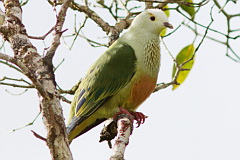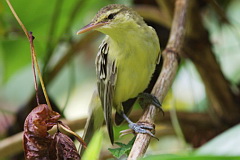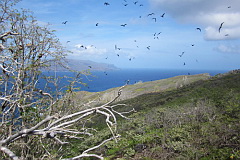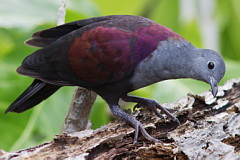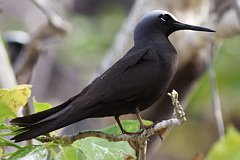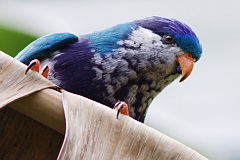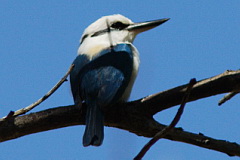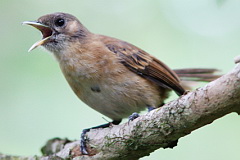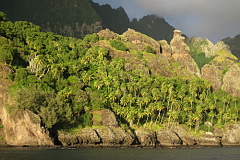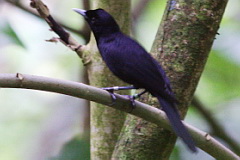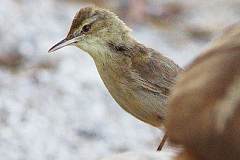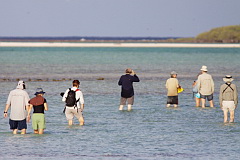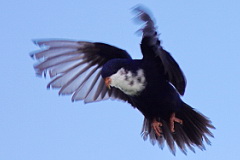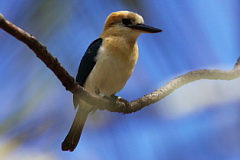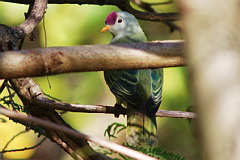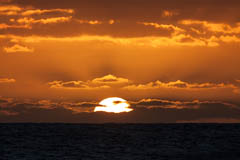This trip report is divided into three parts:
Part 1 - The Pitcairns (Pitcairn, Henderson and Oeno).
Part 2 - The
southern Tuamotus (Teneraro and Morane), Mangareva, Tetiaroa, and Tahiti.
Part 3 - The Marquesas, the northern Tuamotus and Moorea.
Itinerary (Part 3)
23 Sep. Took the early flight to Nuku Hiva, arriving on schedule at 10:30. First impressions at the airfield were the windy conditions and the number of whitecaps out to sea - already looking like déjà vu regarding upcoming sea conditions on the boat. A lone Great Frigatebird was patrolling the airfield. Met by our local guide Teike, bundled into 4x4 vehicles and proceeded directly to Plateau de Toovii where we started a walk toward Vallé d'Aakapa, reputedly the best area for the Nuku Hiva Imperial Pigeon on the island. What was described as a 90 minute walk on wide trails over flat ground turned into a two and a half hour death march on trails oozing mud, up and down inclines, with several stream crossings inside remnant forest patches. Even after the two and a half hour slog we'd failed to reach our destination, so decided to scan from the top of the ridge on the northern side of the island. Many Nuku Hiva Imperial Pigeon passed by. Good to see that the population of this vulnerable species is slowly increasing, as hunting has been much reduced through education. The other island endemics were common - Northern Marquesan Reed Warbler, White-capped Fruit Dove and Marquesan Swiftlet. As ever, introduced species were prolific with Chestnut-breasted Munia, Red-browed Firetail and Red Junglefowl. Just for good measure, rain started on the last part of the trek back to the vehicles. After, we completed the cross-island, 60 kilometre drive, to town and checked into the comfortable and pleasant Mave Mai Guesthouse. Dinner and beers at a local restaurant near the harbour, with excellent food. |
24 Sep. An early breakfast and an hour's drive to the Vallé de Hatiheu and the Marae ruins of Kamuhei Tohua. Unfortunately no sooner had we arrived than the skies opened and our first hour punctuated by some heavy rain showers. Again, good numbers of Nuku Hiva Imperial Pigeon, as well as many White-capped Fruit Dove feeding on the large Ficus trees. Back to the guesthouse, checked-out and back aboard the Braveheart. Following dinner on board, set sail at 20:00 for Hatutu. With the wind and waves prevailing from the rear, a reasonably comfortable night.
25 Sep. We arrived offshore Hatutu at 06:00. The impressive towering cliffs and steep mountain sides of this rugged island made us wonder how landing would be possible. Initial observation from the ship revealed good numbers of Blue Noddy, Great Frigatebird, Red-footed Booby and Common White Tern, as well as a few Sooty Tern and a single Christmas Shearwater. Several groups of Melon-headed Whale passed close to the ship. From the sheltered northern side we took the Naiad jet-boat a kilometre or so to a bay where it was just about possible to nose up to the slippery rocks and, timing the swell correctly, jump off and scamper along the rocks to a small area beneath trees with many nesting Black Noddy. By some incredible luck no sooner had we arrived than a small group of confiding Marquesan Ground Dove were seen feeding on the rocks almost down on the beach. Heading uphill was a distinct challenge due to the thick scrub, total absence of any trails, and boulder strewn slopes. Getting about 200 metres up took best part of 45 minutes and passed close to many nesting frigatebirds which paid almost no attention to us. Good footwear and long trousers essential here for slogging through the vicious scrub. We headed up to an area of taller trees which we investigated for the endemic race of Northern Marquesan Reed Warbler, finding several, as well as a couple more groups of the ground dove. Spent some time around the tallest trees photographing nesting Black Noddy, Common White Tern and Red-footed Booby. Impossible to recognise the same route on the return so spent another hour hacking through scrub. Back to the ship and set sail. Passing the western end of the island were hundreds of Sooty Tern as well as Blue Noddy, Masked Booby, Spectacled Tern, several sharks, further Melon-headed Whale and Southern Bottle-nosed Dolphin. Less than a couple of kilometres out we noticed many Bulwer's Petrel, so stopped to chum and had up to eight Polynesian Storm Petrel as well as Blue Noddy. Finally headed off toward Ua Huka, with rough seas again resulting in few takers for dinner. |
| 26 Sep. Arrived on Ua Huka at Haaveib town around 05:30 with, as inhabited, quick and easy access via a jetty. Impressively, the people of this sizable island have managed to keep it free of the Black Rat, knowing its arrival would spell doom for the two remaining endemics as well as any agricultural implications. Having secured a couple of vehicles we drove the 15 kilometres to the Vallé de Hokatu Botanical Garden, actually more akin to an agricultural research project. A couple of hours walking provided far too many mosquitoes as well as magnificent views of Ultramarine Lorikeet. Iphis Monarch were thin on the ground, in addition to both Northern Marquesan Reed Warbler and Marquesan Swiftlet. Left shortly after lunch and proceeded toward Tahuata, via the western end of Ua Huka where we passed two islets - Hemeni Motus - containing the impressive sight of thousands of breeding Sooty Tern. We also picked out a couple of Spectacled Tern on nearby rocks. Pulling out to sea we passed good numbers of Blue Noddy and a few Polynesian Storm Petrel. En route we also stopped late afternoon for a chumming session which produced Tahiti Petrel, Bulwer's Petrel, Tropical Shearwater and a single Phoenix Petrel. Arrived Tahuata 22:30 and anchored offshore for a peaceful night. 27 Sep. Onto the deck at first light. Amazingly, a scan of the shoreline produced a distant, perched Marquesan Kingfisher; this critically endangered species being our main target. By 06:30 we'd transferred to a different beach, where for once we had an easy landing straight onto a sandy shore from paradise. Although we didn't observe any rats, we saw feral cats, goats and horses. Seabirds seemed few and far between, other than numbers of Blue Noddy and Black Noddy, as well as low numbers of Great Frigatebird, Little White Tern and Brown Noddy. This beach was chosen as Teike had recently found a nest of the kingfisher, and indeed a single bird was present perched high in coconut palms, although it was rather shy, mobile and difficult to photograph. Some investigation of the remaining forest, beach scrub and coconut plantations revealed little, other than a couple of White-capped Fruit Dove and poor views of Southern Marquesan Reed Warbler. |
Great care is required walking through the vegetation here as an introduced wasp is prolific with nests hanging low in the trees every 50 metres or so. Late morning we played at being beach bums for a couple of hours before a barbecue, after which we moved to the first beach we'd observed from the boat, obtaining better views of several Southern Marquesan Reed Warbler, but no further signs of the kingfisher. Late afternoon and evening on the boat, before leaving in the the early hours of the following morning for Mohotani.
28 Sep. Another tricky landing, jumping off a moving boat onto slippery rocks. Being uninhabited and rarely visited necessitated us, or rather Teike, having to cut a trail into the understorey and up a steep, rocky, ravine. Fairly hard going, and it took us well over an hour to reach an elevation of 200 metres where we were finally in monarch habitat, observing several Southern Marquesan Reed Warbler and White-capped Fruit Dove along the way. Not as common as expected we found four Marquesan Monarch in two areas. A single Marquesan Swiftlet was unexpected as not listed in the literature from this island. Sheep were previously a problem on Mohotani but with the government allowing hunting of them, the population has been severely cutback allowing a thick undergrowth to develop. Back down the mountain, on board and set sail to Fatu Hiva, arriving four hours later at 17:30, seeing a collection of the usual at sea plus Tahiti Petrel and Bulwer's Petrel. During the last sunset-hour we cruised along the western shore of the island with its towering cliffs and mountains - a truly impressive sight - that must rate this as one of the most beautiful islands of the world. Unfortunately the goats, viewed clambering around some of the cliffs, were a blot on the landscape. Docked at the bay offshore of Omoa village, one of only two villages on this rather unpopulated island, and were greeted with a stunning display of a large pod of Spinner Dolphin as a finale. A memorable day. |
29 Sep. As the locals, including our Fatu Hivu guide, were at church we had a veritable lay-in till 07:00, followed by a leisurely breakfast and onto Fatu Hivu by 08:00. A grey and overcast morning, following some overnight rain, and indeed there was a hint of more to come as we started to walk the only road away from town into the surrounding valleys.
After 2.5 kilometres we reached the end of the paving and headed off into the surrounding forest. Although this was a short trek of maybe 500 metres, it involved three tricky stream crossings, and plenty of mud, to arrive at a Fatu Hivu Monarch nest where in the next hour we had views of the pair changing at the nest. The future of this critically endangered species hangs in the balance. Until the year 2000, and the arrival of the Black Rat on Fatu Hiva, this species was common in suitable habitat on the island. The current population is estimated at only 40 birds, having recovered from a low of only four pairs some years ago due to a concentrated, and continuing, effort on rat baiting and cat eradication. Mid afternoon we repositioned the boat offshore the only other village on the island, for a peaceful night. |
30 Sep. Left Fatu Hiva at 06:30 to start the long, three day, stretch to Rangiroa. Around 25 kilometres out, over a sea mount, we stopped for a chum session. The usual were present, including a couple of Tahiti Petrel, but the biggest surprise was the sudden appearance of a small Fregetta petrel which passed the boat a couple of times - or maybe two individuals - giving good views. Resembling New Zealand Storm Petrel Oceanites maorianus, but less streaked, the bird was presumably the same as collected by Murphy in this area almost 90 years ago, documented in his paper Birds Collected During the Whitney South Sea Expedition II, published in American Museum Novitates 1924. We were also aware that similar looking lineata birds having been observed near New Caledonia in recent years, and assumed to be a new species. It would seem unlikely however that as the bird collected by Murphy in the Marquesas, being a breeding female, would be the same as those around New Caledonia. The story is however, further clouded by the Murphy and Snyder paper, published in the same journal in 1952, The Pealea Phenomenon And Other Notes On Storm Petrels, in assigning similar looking petrels from across the Pacific to other small species based on the assumption that they are aberrant. Clearly there is another ornithological puzzle awaiting solution here. For the rest of the day we steamed southwest, with birds few and far between. Several greyish Pterodroma petrels were unfortunately too distant for positive identification, except for two individuals in the afternoon passing closer, that were Stejneger's Petrel. A final chumming session just before dark produced only Tahiti Petrel and Bulwer's Petrel. Continued heading toward Rangiroa all night, leaving Marquesan waters during the middle of the night.
1 Oct. A full day on the big blue desert. Only a handful of passing seabirds observed. With the wind dropping, the sea state was considerably better for travel but the lack of wind may have kept petrel activity down. For most of the day the same two Tahiti Petrel kept with us. Other birds in passing included a few Sooty Tern, a Lesser Frigatebird, a single Red-footed Booby and a few Bulwer's Petrel - heavy going.
2 Oct. The wind had picked up by morning, with a rougher sea, but unfortunately the birding did not. During the morning two Tahiti Petrel followed the ship - same birds as yesterday? A chumming session from 08:00 - 09:00 produced zero birds, showing just how devoid of birds these deep waters are. During the afternoon we sailed close to the island of Manihi which held good numbers of Brown Noddy, Black Noddy plus a few Greater Crested Tern, Great Frigatebird and Red-footed Booby. A couple of Tropical Shearwater passed the boat during a chum session. Finally completed the three day voyage to Rangiroa overnight.
3 Oct. At first light we passed through the entry passage into the massive inner lagoon of Rangiroa where, surprising, around 200 Spectacled Tern were lounging on one of the sandy islets. The morning was taken up with trying to find an Internet connection and paperwork with the local gendarmerie. After lunch, Philippe, our guide from Tahiti, joined us and we headed across the main lagoon to the Blue Lagoon - a lagoon within the outer reef - which took over two hours, such is the size of Rangiroa lagoon. Getting to shore, onto the tiny islets here proved to be a drenching affair. Being on the far side of the main lagoon the wind and fetch had created a good chop so after a good drenching getting to the reef we waded to shore, complete with the friendly reef sharks. Very surprisingly, our two target birds were both found easily with several Blue Lorikeet and nesting Tuamotu Reed Warbler. Also present were Pacific Golden Plover, Bristle-thighed Curlew and Wandering Tattler. Night at anchor. 4 Oct. Back onto the same islet early with some of the group wading across the Blue Lagoon to a larger islet in pursuit of Atoll Fruit Dove, but others remaining, trying to improve on yesterday's photography. One group of Blue Lorikeet still present, plus the nesting Tuamotu Reed Warbler. During return to the ship the jet of the Niaid was blocked, necessitating one of the crew to jump into the sea to clear the blockage from below. Immediately on entering the water ten plus reef sharks came circling, forcing the crew prudently back into the boat. After four tries the jet was finally cleared and the sharks remained hungry. We then headed farther south within the lagoon to the rat-free, small islet of Omai. Wading out to the islet the sky was filled with hundreds of breeding Black Noddy, Common White Tern and Red-footed Booby. However, our main quarry was the Polynesian Ground Dove, of which only about eight birds can be supported on this small islet. After a hour or so eluding us, a couple of male birds were seen well at very close range, being tame and confiding. A Long-tailed Koel and a Blue Lorikeet were a nice addition. Returned to the main island of Rangiroa, dropped off crewman Shaun and continued through the night to Niau. Heading directly into the swell gave us a fairly choppy night. |
5 Oct. Arrived at Niau at 06:00 and transferred to the quay where met by the local greeting party, and received the usual leis and greetings. Being little visited we were of course the local celebrities to the small community. Having jumped into three commandeered vehicles we set off southward, through acres of coconut plantations, in search of Tuamotu Kingfisher. After about five kilometres we commenced walking, with it taking around an hour to find our first kingfisher. After a further four hours on the island we managed at least five individuals. Although coconut plantations dominate the landscape, oddly the kingfisher has adapted to the environment, and an education campaign, not to cut down old coconut trees in which it nests, seems to be largely successful. The greatest threat to its survival is the introduced Black Rat which predates successfully on the skinks that form the main basis of the kingfisher's diet. The last count of kingfishers, in 2010, was about 140 birds. After a snorkeling session we set sail to Makatea on a calm sea - gin and tonic on deck, setting sun and no wind - just as we'd imagined the whole trip should have been! 6 Oct. We arrived at Makatea at first light and onto the derelict wharf by 06:30. Eerily silent, with the only the decaying remnants of the mining industry, now covered with forest, to greet us. Abandoned in the late 1960s due to the collapse of phosphate mining, only 50, mostly retired, people now live on the island. Walking around the abandoned railway engines, heavy machinery and accommodation is like stepping back to a bygone era. Recently, plans to reopen the phosphate mining have been afoot, which would be unfortunate for the Polynesian Imperial Pigeon that, with a lack of hunting, has recovered and now numbers around 800 birds. From the wharf we set off up the steep hill to the plateau, on which most of the island resides, and walked the dirt track toward the main settlement. We encountered our first Makatea Fruit Dove after about 30 minutes, but it was not until we stopped around the settlement and scanned the skies, that our first Polynesian Imperial Pigeon flew over. Over the next five hours we walked the old tracks in the regenerated forest, eventually obtaining excellent views of both the dove and pigeon as well as Tuamotu Reed Warbler. Another snorkeling session followed by departure toward Moorea on a medium swell. |
7 Oct. At first light we passed close by Tetiaroa, where we stopped for a chumming session, which like most previous sessions was totally unsuccessful. Continued toward Moorea picking up a few Tahiti Petrel and Tropical Shearwater, before stopping 15 kilometres from Moorea for a final, extended, chumming session, that was also disappointing to say the least. Arrived at Moorea just before lunch to moor for the final time. Afternoon lounging around and snorkeling. Evening party on deck.
8 Oct. An 07:00 planned start for a short trip up into the hills of Moorea. Due to the previous night's festivities and fruit punch, two of the planned participants didn't make it due sore heads, aka a hangover. Took a bus up to the viewpoint of the Vallé de Opunohu where we easily found the Moorea race of Society Kingfisher, although obtaining good views was somewhat frustrated. This race differs markedly from the nominate on Tahiti in showing no sexual dimorphism and lacking any blue in the plumage - clearly a candidate for a future split. The next couple of hours were spent in a slow amble downhill to the main archeological ruins, seeing Grey-green Fruit Dove and the usual introductions. En route, during the morning, we also had Pacific Golden Plover, Pacific Black Duck and Little Heron - the later apparently a vagrant on Moorea where not previously documented. By 10:15 back at the quay, where we tried to attract the attention of last night's partygoers by waving and jumping around. No luck at all, so John decided to rent a canoe from the nearby hotel and paddle out. Great plan until the return leg when being towed by the zodiac it capsized, in effect going for an early swim. Early afternoon farewells, as the group split up for various routes home. Fast ferry to Papeete, 35 minutes, and an overnight at Fare-Suisse Guesthouse again.
9 Oct. Air Tahiti to Auckland, recrossing the dateline to 10 Oct. Overnight at Jet Park Hotel.
11 Oct. Thai Airways to Bangkok and return home.
Part 1 - The Pitcairns (Pitcairn, Henderson and Oeno).
Part 2 - The
southern Tuamotus (Teneraro and Morane), Mangareva, Tetiaroa, and Tahiti.
Part 3 - The Marquesas, the northern Tuamotus and Moorea.
Galleries
Bird images from this, and other, birding trips.
Travel images from this, and other, birding trips.
Species List (Part 3)
Taxonomy and nomenclature follow IOC World Bird List, version 3.4 (2013). However, a number of highly distinctive regional taxa, that are strong candidates for specific status, are included and indicated by trinomial scientific names.
| Nuku Hiva | Count | ||
| Red Junglefowl | Gallus gallus | 100 | |
| White-tailed Tropicbird | Phaethon lepturus | 3 | |
| Great Frigatebird | Fregata minor | 1 | |
| Lesser Frigatebird | Fregata ariel | 4 | |
| Wandering Tattler | Tringa incana | 2 | |
| Brown Noddy | Anous stolidus | 10 | |
| Little White Tern | Gygis alba microrhyncha | 40 | |
| Zebra Dove | Geopelia striata | 30 | |
| White-capped Fruit-Dove | Ptilinopus dupetithouarsii | 100 | |
| Nuku Hiva Imperial Pigeon | Ducula galeata | 30 | |
| Marquesan Swiftlet | Aerodramus ocistus | 20 | |
| Northern Marquesan Reed Warbler | Acrocephalus percernis | 40 | |
| Red-browed Firetail | Emblema temporalis | 4 | |
| Chestnut-breasted Munia | Lonchura castaneothorax | 30 | |
| Hatutu | Count | ||
| Great Frigatebird | Fregata minor | 300 | |
| Lesser Frigatebird | Fregata ariel | 50 | |
| Masked Booby | Sula dactylatra | 12 | |
| Red-footed Booby | Sula sula | 40 | |
| Brown Booby | Sula leucogaster | 15 | |
| Bristle-thighed Curlew | Numenius tahitiensis | 1 | |
| Wandering Tattler | Tringa incana | 2 | |
| Brown Noddy | Anous stolidus | 40 | |
| Black Noddy | Anous minutus | 600 | |
| Blue Noddy | Procelsterna cerulea | 300 | |
| Common White Tern | Gygis alba | 80 | |
| Sooty Tern | Onychoprion fuscatus | 1,000 | |
| Marquesan Ground Dove | Pampusana rubescens | 14 | |
| Northern Marquesan Reed Warbler | Acrocephalus percernis | 4 | |
| Ua Huka | Count | ||
| Red Junglefowl | Gallus gallus | 25 | |
| Phoenix Petrel | Pterodroma alba | 1 | |
| Tahiti Petrel | Pseudobulweria rostrata | 3 | |
| Tropical (Audubon's) Shearwater | Puffinus bailloni | 15 | |
| Bulwer's Petrel | Bulweria bulwerii | 20 | |
| Polynesian Storm Petrel | Nesofregetta fuliginosa | 2 | |
| White-tailed Tropicbird | Phaethon lepturus | 2 | |
| Pacific Reef Heron | Egretta sacra | 2 | |
| Lesser Frigatebird | Fregata ariel | 2 | |
| Red-footed Booby | Sula sula | 10 | |
| Brown Booby | Sula leucogaster | 4 | |
| Bristle-thighed Curlew | Numenius tahitiensis | 1 | |
| Wandering Tattler | Tringa incana | 2 | |
| Black Noddy | Anous minutus | 2 | |
| Spectacled Tern | Onychoprion lunatus | 4 | |
| Zebra Dove | Geopelia striata | 6 | |
| White-capped Fruit-Dove | Ptilinopus dupetithouarsii | 5 | |
| Ultramarine Lorikeet | Vini ultramarina | 20 | |
| Marquesan Swiftlet | Aerodramus ocistus | 15 | |
| Iphis Monarch | Pomarea iphis | 6 | |
| Northern Marquesan Reed Warbler | Acrocephalus percernis | 8 | |
| Chestnut-breasted Munia | Lonchura castaneothorax | 15 | |
| Tahuata | Count | ||
| Red Junglefowl | Gallus gallus | 20 | |
| White-tailed Tropicbird | Phaethon lepturus | 2 | |
| Pacific Reef Heron | Egretta sacra | 4 | |
| Great Frigatebird | Fregata minor | 2 | |
| Red-footed Booby | Sula sula | 6 | |
| Brown Booby | Sula leucogaster | 4 | |
| Wandering Tattler | Tringa incana | 4 | |
| Brown Noddy | Anous stolidus | 10 | |
| Black Noddy | Anous minutus | 30 | |
| Blue Noddy | Procelsterna cerulea | 30 | |
| Little White Tern | Gygis alba microrhyncha | 30 | |
| Zebra Dove | Geopelia striata | 15 | |
| White-capped Fruit-Dove | Ptilinopus dupetithouarsii | 3 | |
| Marquesan Kingfisher | Todiramphus godeffroyi | 2 | |
| Southern Marquesan Reed Warbler | Acrocephalus mendanae | 4 | |
| Red-browed Firetail | Emblema temporalis | 6 | |
| Chestnut-breasted Munia | Lonchura castaneothorax | 20 | |
| Mohotani | Count | ||
| Red Junglefowl | Gallus gallus | 10 | |
| Tahiti Petrel | Pseudobulweria rostrata | 1 | |
| Wedge-tailed Shearwater | Ardenna pacifica | 20 | |
| Bulwer's Petrel | Bulweria bulwerii | 15 | |
| Great Frigatebird | Fregata minor | 1 | |
| Red-footed Booby | Sula sula | 2 | |
| Brown Booby | Sula leucogaster | 1 | |
| Wandering Tattler | Tringa incana | 2 | |
| Brown Noddy | Anous stolidus | 20 | |
| Black Noddy | Anous minutus | 20 | |
| Blue Noddy | Procelsterna cerulea | 30 | |
| Little White Tern | Gygis alba microrhyncha | 40 | |
| Sooty Tern | Onychoprion fuscatus | 3 | |
| Zebra Dove | Geopelia striata | 10 | |
| White-capped Fruit-Dove | Ptilinopus dupetithouarsii | 6 | |
| Marquesan Swiftlet | Aerodramus ocistus | 1 | |
| Marquesan Monarch | Pomarea mendozae | 4 | |
| Southern Marquesan Reed Warbler | Acrocephalus mendanae | 4 | |
| Fatu Hiva | Count | ||
| Bulwer's Petrel | Bulweria bulwerii | 10 | |
| White-tailed Tropicbird | Phaethon lepturus | 2 | |
| Lesser Frigatebird | Fregata ariel | 2 | |
| Red-footed Booby | Sula sula | 3 | |
| Brown Booby | Sula leucogaster | 3 | |
| Wandering Tattler | Tringa incana | 2 | |
| Brown Noddy | Anous stolidus | 10 | |
| Black Noddy | Anous minutus | 20 | |
| Blue Noddy | Procelsterna cerulea | 30 | |
| Little White Tern | Gygis alba microrhyncha | 20 | |
| Sooty Tern | Onychoprion fuscatus | 4 | |
| White-capped Fruit-Dove | Ptilinopus dupetithouarsii | 12 | |
| Fatuhiva Monarch | Pomarea whitneyi | 2 | |
| Southern Marquesan Reed Warbler | Acrocephalus mendanae | 6 | |
| Chestnut-breasted Munia | Lonchura castaneothorax | 12 | |
| Rangiroa | Count | ||
| Pacific Reef Heron | Egretta sacra | 4 | |
| Great Frigatebird | Fregata minor | 5 | |
| Lesser Frigatebird | Fregata ariel | 2 | |
| Red-footed Booby | Sula sula | 30 | |
| Brown Booby | Sula leucogaster | 2 | |
| Pacific Golden Plover | Pluvialis fulva | 2 | |
| Bristle-thighed Curlew | Numenius tahitiensis | 3 | |
| Wandering Tattler | Tringa incana | 4 | |
| Brown Noddy | Anous stolidus | 20 | |
| Black Noddy | Anous minutus | 400 | |
| Grey Noddy | Procelsterna albivitta | 4 | |
| Common White Tern | Gygis alba | 40 | |
| Greater Crested Tern | Thalasseus bergii | 8 | |
| Spectacled Tern | Onychoprion lunatus | 2 | |
| Sooty Tern | Onychoprion fuscatus | 4 | |
| Polynesian Ground Dove | Pampusana xanthonura | 2 | |
| Blue Lorikeet | Vini peruviana | 8 | |
| Long-tailed Koel | Urodynamis taitensis | 1 | |
| Tuamotu Reed Warbler | Acrocephalus atyphus | 3 | |
| Niau | Count | ||
| Red Junglefowl | Gallus gallus | 10 | |
| Tahiti Petrel | Pseudobulweria rostrata | 2 | |
| Pacific Reef Heron | Egretta sacra | 8 | |
| Great Frigatebird | Fregata minor | 4 | |
| Lesser Frigatebird | Fregata ariel | 2 | |
| Brown Booby | Sula leucogaster | 4 | |
| Wandering Tattler | Tringa incana | 6 | |
| Brown Noddy | Anous stolidus | 10 | |
| Black Noddy | Anous minutus | 20 | |
| Common White Tern | Gygis alba | 10 | |
| Atoll Fruit-Dove | Ptilinopus coralensis | 10 | |
| Tuamotu Kingfisher | Todiramphus gambieri | 5 | |
| Tuamotu Reed Warbler | Acrocephalus atyphus | 10 | |
| Makatea | Count | ||
| Tahiti Petrel | Pseudobulweria rostrata | 3 | |
| Pacific Reef Heron | Egretta sacra | 2 | |
| Great Frigatebird | Fregata minor | 4 | |
| Lesser Frigatebird | Fregata ariel | 1 | |
| Red-footed Booby | Sula sula | 20 | |
| Pacific Golden Plover | Pluvialis fulva | 1 | |
| Wandering Tattler | Tringa incana | 1 | |
| Brown Noddy | Anous stolidus | 4 | |
| Black Noddy | Anous minutus | 2 | |
| Common White Tern | Gygis alba | 10 | |
| Makatea Fruit Dove | Ptilinopus chalcurus | 12 | |
| Polynesian Imperial Pigeon | Ducula aurorae | 7 | |
| Tuamotu Reed Warbler | Acrocephalus atyphus | 10 | |
| Silvereye | Zosterops lateralis | 40 | |
| Moorea | Count | ||
| Red Junglefowl | Gallus gallus | 20 | |
| Pacific Black Duck | Anas superciliosa | 3 | |
| Tahiti Petrel | Pseudobulweria rostrata | 5 | |
| Tropical Shearwater | Puffinus bailloni | 4 | |
| Little Heron | Butorides atricapilla | 1 | |
| Pacific Golden Plover | Pluvialis fulva | 1 | |
| Brown Noddy | Anous stolidus | 30 | |
| Common White Tern | Gygis alba | 10 | |
| Greater Crested Tern | Thalasseus bergii | 15 | |
| Rock Dove | Columba livia | 20 | |
| Zebra Dove | Geopelia striata | 5 | |
| Grey-green Fruit Dove | Ptilinopus purpuratus | 8 | |
| Society Kingfisher | Todiramphus veneratus | 6 | |
| Red-vented Bulbul | Pycnonotus cafer | 20 | |
| Silvereye | Zosterops lateralis | 30 | |
| Common Myna | Acridotheres tristis | 120 |

